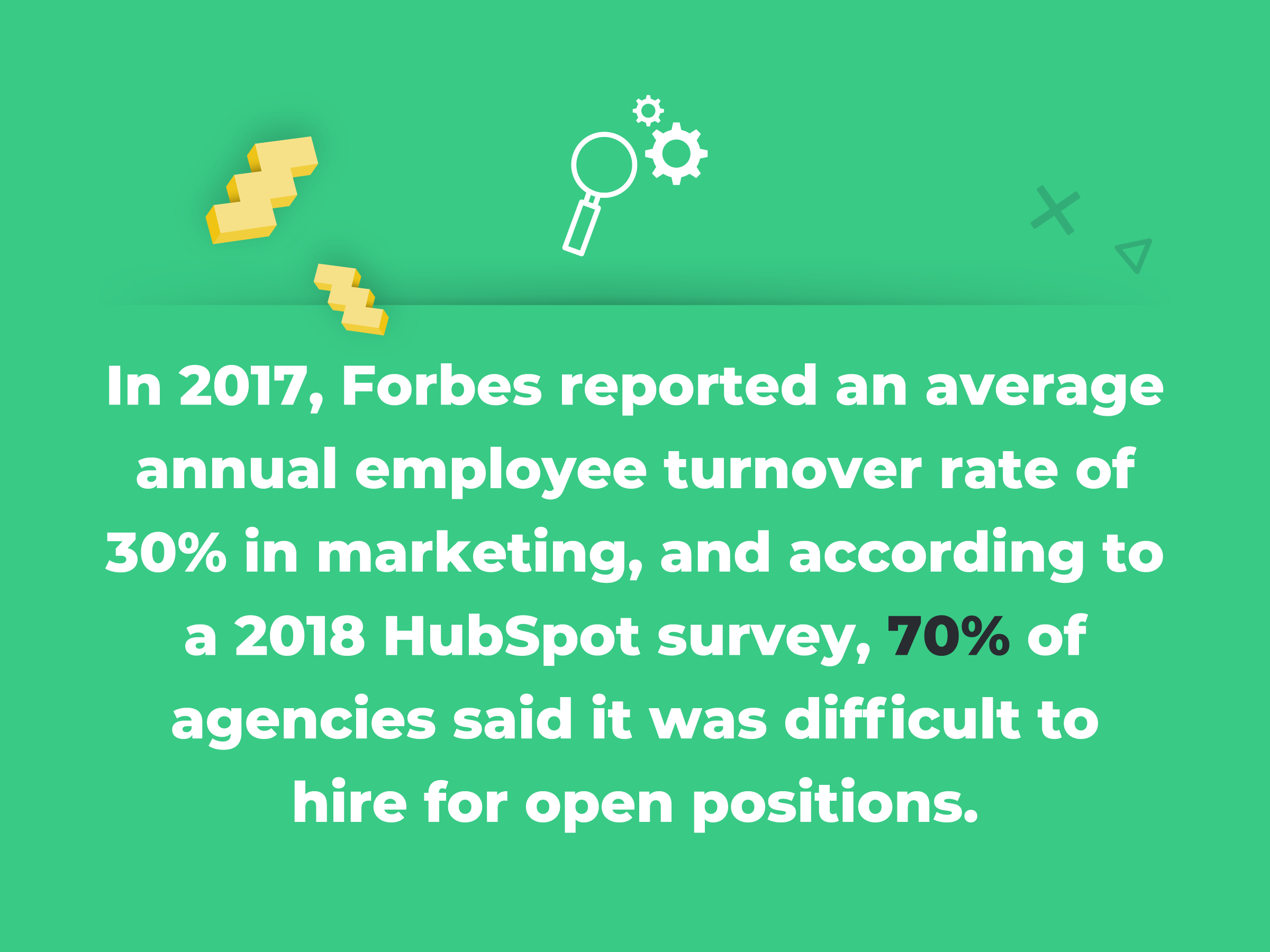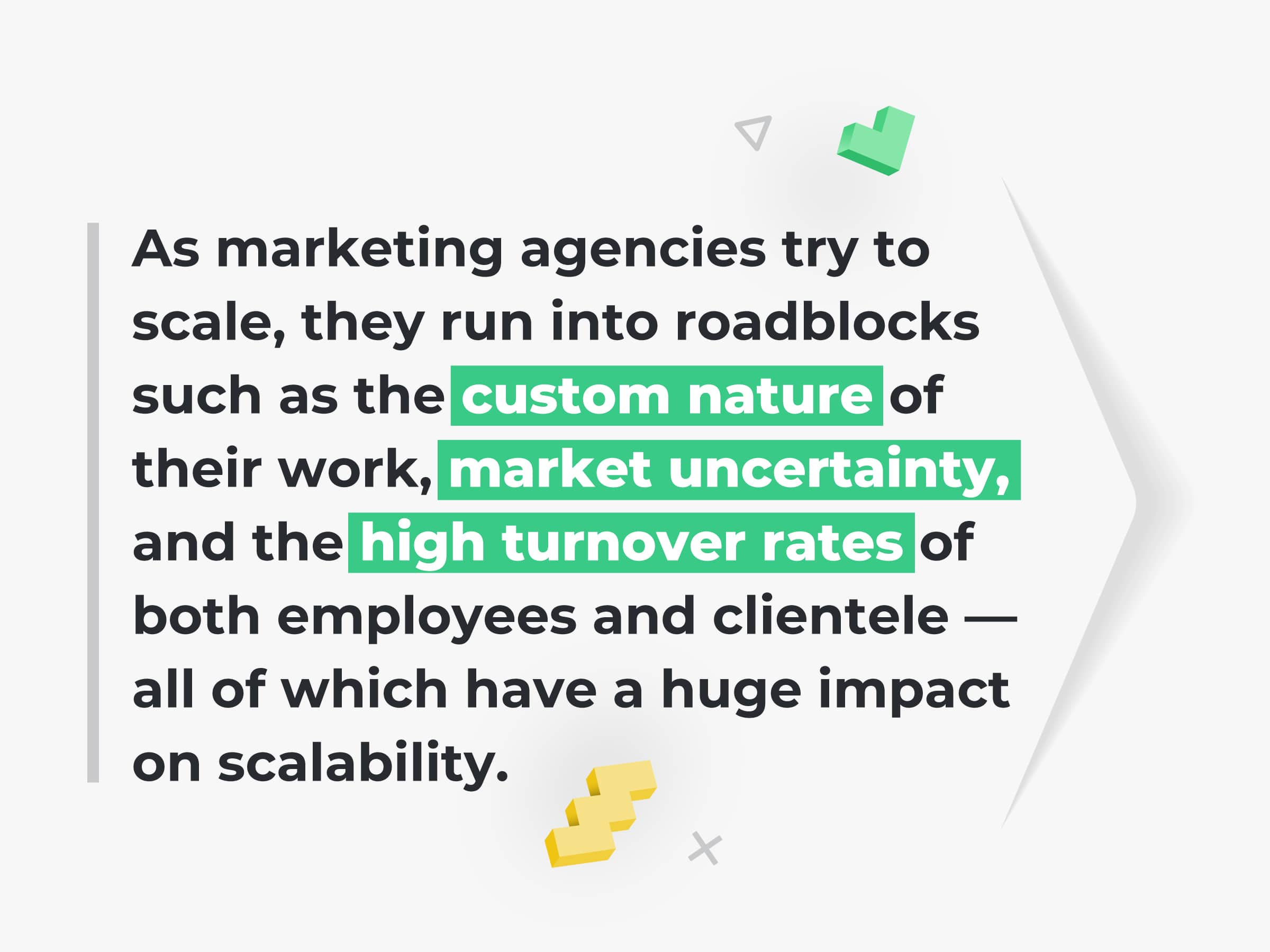As service businesses, marketing agencies are infamously difficult to scale. By definition, a service business provides a specialized service, one that takes costly time and energy to generate for their clients. This one-to-one relationship between an agency and the client means that in order to scale, an agency will need to hire more employees, which means more costs without increasing efficiency.
When it comes to scaling a service business, experts advise streamlining the service itself with the goal of operating more like a product business. If agencies package their service as a one-size-fits-all product, they spend less time and energy on customization per client, and they can sell to a greater number of clients without hiring an expensive army of employees. Easy solution, right? Not necessarily. Read on to learn more, and download this white paper for an even deeper look into the challenges of scaling a marketing agency.

The Necessity of Custom Creative Work
The reality is, marketing agencies can’t simply transform all of their custom creative work into a single product. Instead, agencies have to tailor their services to suit the needs of each individual client. This means that solutions that work for one client will need significant customization to work for another.
As easy as it would be, you can’t simply take an existing marketing campaign and put another client’s name on it. Especially when you consider the wide variety of industries that require marketing services, it is nearly impossible to transform this fundamentally custom service into a single product that works just as well for all, or even most, clients.
To take it a step further, remember that your agency’s custom creative work is the feature that sets you apart from other agencies. The creative work itself is what convinces a client to work with you, over all of your competitors. Even though it’s key to an agency’s success, creative work keeps agencies from scaling the way product-based businesses are able to scale.
For other businesses, the product they sell might be the feature that sets them apart from the competition. Unlike marketing agencies, they don’t have to invest as much time and energy into creating customized solutions for each customer, meaning they can scale with more ease. And let’s not forget that agencies are competing with the individualized marketing capabilities of an in-house team. Clients want to know that an agency will provide them with the same high-quality, customized creative solutions that an in-house team would provide.

An Increasingly Competitive Field
On top of that, creative work is even more important to marketing agencies in light of the immense competition they face. Promethean Research’s Digital Marketing Agency Industry Report estimates that the number of digital marketing agencies has increased by approximately 23% since 2019. With new technology, the costs of setting up an agency are low, which has led to an explosion in the number of small marketing agencies in recent years. According to Digital Information World’s 2020 analysis of 6,000 U.S. marketing agencies, 67% of these agencies were established in the past 20 years.
With all of this new competition cropping up left and right, it is important for agencies to differentiate themselves from their competitors in order to scale and increase their clientele. Because this differentiation comes in the form of individualized creative work, it is even more vital for agencies to demonstrate their value through customized marketing solutions.
Another difficulty for marketing agencies is their inability to provide proof of their service before a client agrees to purchase it. In part, this issue stems from agencies’ difficulty tracking marketing ROI. From the client’s perspective, it may seem like a safer bet to go through the costly process of hiring someone to work in-house, rather than choosing a marketing agency that can’t prove it is worth the investment.

The Impact of the Market Itself on Marketing
An additional problem is the instability of the market. As agencies are well aware, marketing budgets vary depending on the market itself. When the market crashes, marketing budgets are the first to be cut in order to save money. This is problematic for scaling as it leaves marketing agencies on unstable ground and dependent on the market for their pricing.
However, it’s not all doom and gloom. In terms of today’s economic downturn brought on by COVID-19, the impact on marketing budgets is still unfolding. A recent report from Merkle states that rather than cutting budgets and pulling marketing campaigns, 52% of companies across a variety of industries reported increasing their marketing spend since the start of the pandemic.
In this new reality, marketers are looking for innovative ways to reach consumers digitally, with 79% of marketers changing their approach to content. So, even though marketing budgets have historically been the first on the chopping block during economic downturns, the early numbers for the current recession seem slightly more optimistic.

High Turnover Rates for Employees and Clients
Another issue standing in the way of scaling is the high employee turnover rate in the marketing industry. In late 2017, Forbes reported an average annual employee turnover rate of 30% in this industry, a revolving door phenomenon that is expensive. According to a 2018 HubSpot survey, 70% of agency respondents said that it was difficult to hire for open positions. As agencies lose employees, they devote energy and resources to continually recruit and find replacements.
To make matters worse, there is concern in the industry over the growing skills gap among marketing job seekers. In a survey of 500 marketers conducted by Econsultancy and SmartFocus, 30% of respondents said that it is very difficult to find marketers with the right skills to fill open positions. Altogether, this means agencies are constantly looking for new employees in a pool of job seekers that don’t have the right skills to begin with, which presents yet another challenge for scaling.
There is one final challenge to add to the list: Agencies’ high customer churn rate is another roadblock to scaling. As reported by the Local Search Association, companies that sell digital marketing services to small and medium businesses experience a 50% average customer churn rate each year. These agencies are losing half of their clientele annually which presents a significant hurdle to scaling. Without customers, how can an agency make money?
You might think the solution to this problem is to bring in more customers each year to make up for the ones agencies lose —but that’s another difficulty for agencies. In a 2018 HubSpot survey, 60% of agencies reported that their biggest pain point in terms of their growth concerned finding new clients. Customer retention and acquisition are key to scaling an agency, and the difficulties agencies encounter in these areas present obstacles to scaling.
Final Thoughts
To sum it all up, as marketing agencies try to scale, they run into roadblocks that product-based companies simply do not encounter. These issues — such as the custom nature of agencies’ work, market uncertainty, and the high turnover rates of both employees and clientele — have a huge impact on scalability.
At this point, things might seem pretty bleak. You might be wondering, what can an agency do to overcome all of these obstacles to scaling? Luckily, there are ways that marketing agencies can significantly reduce the time and effort needed to create customized solutions and improve their margins by up to 50%. You can learn more about it by downloading this white paper that explains highly effective strategies for scaling a marketing agency.







